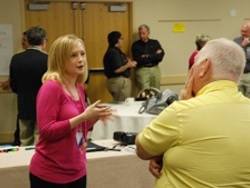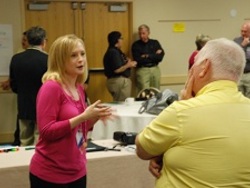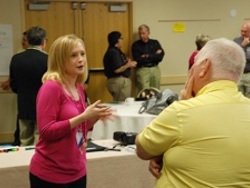


“Sam Walton was a great storyteller,” said Lee Scott, the former CEO of Wal-Mart. He went on to confront his executives by saying, “All you do at meetings is give statistics and show PowerPoint slides. You need to learn how to tell stories."
Long before Wal-Mart began selling actual “power tools”, cavemen told stories by carving pictures on stone walls. They soon realized stories were a powerful tool. They could change emotions; they could make people happy, sad, angry or frightened. How can we also use stories to influence others and bring about profound change? As Bob Pike says, “Learning has NOT taken place until behavior has changed!”
Why are stories such a powerful tool?
I + E = LTM
Information plus emotion equals long term memory.
Many trainers give facts and stop there. Stories take facts and add emotion to it. It’s a powerful combination that helps people retain information. When you kick information into long term memory, you can ultimately persuade and move people to action. After all is said and done and you finish your training, what do people remember? The stories!
Let me share with you a few of the tips I shared with the Wal-Mart executives as I led them in a storytelling workshop so they could tell stories to change behavior and drive business results!
Paint a picture. Just like an artist, the best storytellers paint a visual picture in the mind of the audience. Don't just tell them the story; show it to them. Relive the story. If you had the audience close their eyes, could they see it?
Use silence, the powerful pause. Most people feel uncomfortable with silence but silence is one of the most powerful tools you can use. When you use silence, don't forget eye contact as well. When you hold the silence and maintain direct eye contact (4-5 seconds until you feel uncomfortable), the entire audience will feel that you are connecting with them individually.
Write your stories out. The tendency is to "wing it" and tell it off the cuff. So often when we do this, we include many things that distract the audience from the core message. Writing your stories out will help you eliminate the irrelevant.
Use vocal variety and body language. Thirty-eight percent of how we communicate is our vocal variety and voice inflection. Fifty-five percent of how we communicate is our body language. How can you act out and demonstrate the story with your body and voice inflection?
Use vivid words. Words with hard consonants have more impacting. The word “cracked” is more dramatic and vivid than the word “opened”. After telling your story, look back at how you can replace some less powerful words and make them come to life.
Stories make for powerful openings or closings. Don't be afraid to start out immediately with a story. Avoid starting by saying, “And now I am going to tell you a story.…” People remember the first and last thing you say. You only have one opportunity to make a first impression. Grab the audience right from the beginning!
Consider making it interactive. Most people tell stories and don't involve the audience. Think about how you can get the audience to tell the story with you. How can get them to say a key phrase or word when you signal them?
Want more tips? Attend the next storytelling session at the 21st Annual Creative Training Techniques Conference. Click here for more information.
Don't miss out on updates and chances
to sharpen your skills with participant-centered learning.




3740 N Chestnut St #113 - Chaska, MN 55318-3053